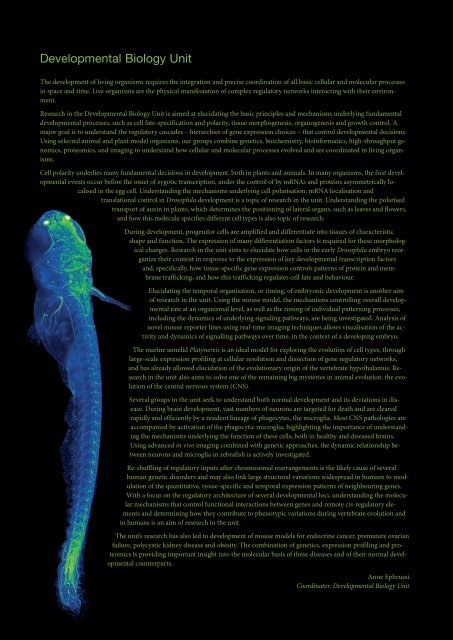Create successful ePaper yourself
Turn your PDF publications into a flip-book with our unique Google optimized e-Paper software.
Developmental Biology Unit<br />
The development of living organisms requires the integration and precise coordination of all basic cellular and molecular processes<br />
in space and time. Live organisms are the physical manifestation of complex regulatory networks interacting with their environment.<br />
Research in the Developmental Biology Unit is aimed at elucidating the basic principles and mechanisms underlying fundamental<br />
developmental processes, such as cell fate-specification and polarity, tissue morphogenesis, organogenesis and growth control. A<br />
major goal is to understand the regulatory cascades – hierarchies of gene expression choices – that control developmental decisions.<br />
Using selected animal and plant model organisms, our groups combine genetics, biochemistry, bioinformatics, high-throughput genomics,<br />
proteomics, and imaging to understand how cellular and molecular processes evolved and are coordinated in living organisms.<br />
Cell polarity underlies many fundamental decisions in development, both in plants and animals. In many organisms, the first developmental<br />
events occur before the onset of zygotic transcription, under the control of by mRNAs and proteins asymmetrically localised<br />
in the egg cell. Understanding the mechanisms underlying cell polarisation, mRNA localisation and<br />
translational control in Drosophila development is a topic of research in the unit. Understanding the polarised<br />
transport of auxin in plants, which determines the positioning of lateral organs, such as leaves and flowers,<br />
and how this molecule specifies different cell types is also topic of research.<br />
During development, progenitor cells are amplified and differentiate into tissues of characteristic<br />
shape and function. The expression of many differentiation factors is required for these morphological<br />
changes. Research in the unit aims to elucidate how cells in the early Drosophila embryo reorganize<br />
their content in response to the expression of key developmental transcription factors<br />
and, specifically, how tissue-specific gene expression controls patterns of protein and membrane<br />
trafficking, and how this trafficking regulates cell fate and behaviour.<br />
Elucidating the temporal organisation, or timing, of embryonic development is another aim<br />
of research in the unit. Using the mouse model, the mechanisms controlling overall developmental<br />
rate at an organismal level, as well as the timing of individual patterning processes,<br />
including the dynamics of underlying signaling pathways, are being investigated. Analysis of<br />
novel mouse reporter lines using real-time imaging techniques allows visualisation of the activity<br />
and dynamics of signalling pathways over time, in the context of a developing embryo.<br />
The marine annelid Platynereis is an ideal model for exploring the evolution of cell types, through<br />
large-scale expression profiling at cellular resolution and dissection of gene regulatory networks,<br />
and has already allowed elucidation of the evolutionary origin of the vertebrate hypothalamus. Research<br />
in the unit also aims to solve one of the remaining big mysteries in animal evolution: the evolution<br />
of the central nervous system (CNS).<br />
Several groups in the unit seek to understand both normal development and its deviations in disease.<br />
During brain development, vast numbers of neurons are targeted for death and are cleared<br />
rapidly and efficiently by a resident lineage of phagocytes, the microglia. Most CNS pathologies are<br />
accompanied by activation of the phagocytic microglia, highlighting the importance of understanding<br />
the mechanisms underlying the function of these cells, both in healthy and diseased brains.<br />
Using advanced in vivo imaging combined with genetic approaches, the dynamic relationship between<br />
neurons and microglia in zebrafish is actively investigated.<br />
Re-shuffling of regulatory inputs after chromosomal rearrangements is the likely cause of several<br />
human genetic disorders and may also link large structural variations widespread in humans to modulation<br />
of the quantitative, tissue-specific and temporal expression patterns of neighbouring genes.<br />
With a focus on the regulatory architecture of several developmental loci, understanding the molecular<br />
mechanisms that control functional interactions between genes and remote cis-regulatory elements<br />
and determining how they contribute to phenotypic variations during vertebrate evolution and<br />
in humans is an aim of research in the unit.<br />
The unit’s research has also led to development of mouse models for endocrine cancer, premature ovarian<br />
failure, polycystic kidney disease and obesity. The combination of genetics, expression profiling and proteomics<br />
is providing important insight into the molecular basis of these diseases and of their normal developmental<br />
counterparts.<br />
Anne Ephrussi<br />
Coordinator, Developmental Biology Unit













